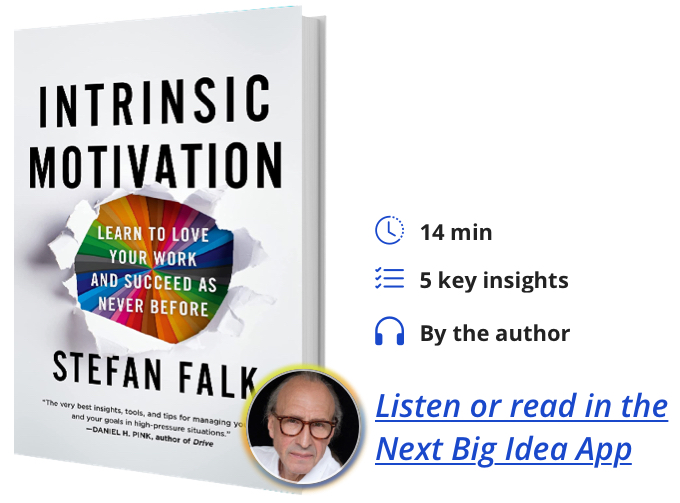Stefan Falk is an internationally-recognized executive coach and human performance expert. A McKinsey & Company alumnus specializing in leadership and corporate transformation, he has trained over 4,000 leaders across more than 60 different client organizations in North America and Europe. He has held C-suite roles at several global companies, and has been responsible for driving corporate transformations valued in excess of two billion dollars. His leadership and human performance techniques have been developed in continuous cooperation with leading scientists in fields including neuroscience, behavioral science, and psychology. He is the coauthor of Neuroleadership.
Below, Stefan shares 5 key insights from his new book, Intrinsic Motivation: Learn to Love Your Work and Succeed as Never Before. Listen to the audio version—read by Stefan himself—in the Next Big Idea App.

1. Challenging yourself must become second nature.
Intrinsic motivation is when you do something for its own sake; the motivation comes from loving the experience of performing the activity. This happens when we feel challenged in a good way because that’s when you perform at our best and develop skills, which your brain rewards with a sense of fulfilling experience.
Developing ourselves has been a central strategy for our survival as human beings, so it is logical that our brain is built to reward us when we do. People who master intrinsic motivation can switch on their intrinsic motivation by challenging themselves in a good way to develop their skills when they need to.
There are several situations when the ability to switch on your intrinsic motivation is important: when you are bored, afraid, uncomfortable, under stress and pressure, and when you need to perform better, learn something new, or improve your work relationships.
These situations are often not dealt with in a good way when you are not intrinsically motivated by them. If you learn to channel intrinsic motivation, it will help you achieve better results and enjoy greater rewards, which over time (given that you achieve mastery in your work) leads to bigger opportunities, health, and success.
But challenging yourself when you need to requires energy. Your mindset needs to embrace the fact that the way you perform tasks can be infinitely improved, even if you perform them well already. The problem is that spending energy is something our energy-conserving nature is not happy about unless you acquire the taste and skill to do so in a systematic and energy-efficient way. To make challenging yourself energy-efficient, you need to rewire your brain to send red alerts in situations where you should not be lazy but instead unlock your intrinsic motivation by challenging yourself.
2. Activity-focused behavior is the main reason for stress and dissatisfaction at work.
Because we are lazy and energy-conserving creatures, we often stop challenging ourselves when we think we know how to perform a task. When this happens, you risk engaging in activity-focused behavior, which means performing tasks mostly on habit in the same way repeatedly.
Performing tasks on habit is good from an energy-saving perspective, but it often leads to a vicious cycle. You will gradually be less insightful about how you perform tasks because when we operate on habit, we think very little about how we do things. So, when asked to work faster or produce a better result, you don’t even know where to start.
“Boredom encourages procrastination, which creates backlogs of to-do’s, missed deadlines, low work satisfaction, and stress.”
You also become bored because you don’t feel challenged. Boredom encourages procrastination, which creates backlogs of to-do’s, missed deadlines, low work satisfaction, and stress.
Failure at work also becomes painful, because you spend time on something you don’t particularly enjoy. In the longer-term, activity-focused behavior hurts your brain by weakening its potential. This can also cause the brain to age faster.
Based on my experience, it is activity-focused behavior—not the work environment—that is the major reason why many professionals suffer from negative stress, anxiety, and burnout, and engage in a phenomenon called quiet quitting.
3. Make it second nature to challenge yourself.
Whenever you experience boredom, engage in exciting-outcome focused behavior. This means that you create your own challenge by defining an exciting outcome that will challenge you to develop your skills when performing the task.
This approach snaps you out of activity-focused behavior to instead activate your brain to solve an interesting problem. Now, activating the brain is painful for all of us, but the pain is a sign that the brain is in learning mode. But if you start defining exciting outcomes for one to two tasks every day, you will quickly reduce the pain because you are rewiring your brain to make this second nature and less energy-consuming.
You can define exciting outcomes in three ways when you are bored: decrease the time, increase the complexity, or improve the benefits (for others and yourself) by performing the task in a better way. The easiest approach is decreasing the time it should take to perform the task while still achieving the same or a better work result. Cutting the time in half compared to the time you usually spend is a good way to think about it.
“You can define exciting outcomes in three ways when you are bored: decrease the time, increase the complexity, or improve the benefits.”
I use this approach every day to sharpen my mind to perform better and to make sure that I continuously improve some aspect of my client work. I often imagine that I would have only half the time with a client and then ask myself what I would do differently to still be able to achieve a great result. It is pure magic to think this way.
I often ask clients to redo their plans by using half of the time they initially thought they should use. It always leads to better plans and results, including excitement and learning. Decreasing time also works for meetings and projects. I have clients who have managed to reduce time for huge projects, like reorganizations, from nine months to three months, and with better results.
4. Challenge yourself to always ask how big the problem is.
I estimate that as many as 80 percent of the problems people work on in companies are either non-existent, less important compared to problems not addressed, or addressed in the wrong way. The main reason is that the most important question is seldom asked, namely: How big is the problem? This goes unasked because we are energy-conserving and do things without deeper thinking.
Your mind should set off a red alert every time you face a problem, especially if you feel certain that you understand the problem. When we feel completely certain is when we make the biggest mistakes.
Make it second nature to ask questions like: How frequently does the problem occur? What tangible negative consequences does it cause? What additional value and benefits can be captured by solving the problem? What data and facts do I need to answer these questions without being biased by my own or other’s opinions and experience?
Do this and you will become engrossed in the problems you face, making you more intrinsically motivated. Answering how big the problem is will also help with prioritization. If you understand the size of a problem, you can compare it to everything else on your agenda and budget your time and effort accordingly. This will give you a greater sense of control, which reduces stress and builds motivation for work.
“If you understand the size of a problem, you can compare it to everything else on your agenda and budget your time and effort accordingly.”
It also builds courage and ability to deal with emotionally uncomfortable problems, for example, a bad working relationship with a colleague. By analyzing how big the problem is, you get a deeper understanding of the problem and can devise a mindful solution, including letting it go if it is not a big problem.
5. Leave your ego at home.
Being governed by selfish needs makes you less intelligent and gives you tunnel vision, as you will only register the elements of your situation that relate to yourself. This bias will affect everything you do, from how you perform tasks, how you engage with colleagues and stakeholders, to what you can learn.
Putting your needs first also causes negative stress because you take everything that doesn’t meet your needs as a negative. You will most likely leave work feeling frustrated, burdened by negative thoughts about people who, like you, allowed themselves to be governed by selfish needs. All this can negatively affect your ability to feel intrinsically motivated at work, unless you stop letting your ego get in the way when you engage with people at work.
Leave your ego at home by making it second nature to ask for feedback after work interactions. When you practice this every day, your brain rewires to take your mind’s ever-present focus on your own needs out. At the same time, you make the people you’ve ask for feedback feel respected, important, and influential. Beyond that, you will get useful ideas for self-improvement, and gain insights into how people think and feel, which over time will enable you to get what you need from them.
Do you this on a regular basis by committing to always asking for feedback after any interaction. For example, after meetings, any type of delivery, quick calls, and email exchanges. Here are some examples of feedback questions:
- Was this helpful for you?
- Was this what you expected?
- Was this time well invested for you?
To listen to the audio version read by author Stefan Falk, download the Next Big Idea App today:































